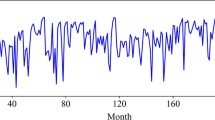Abstract
Accurate forecast of future container throughput of a port is very important for its construction, upgrading, and operation management. This study proposes a transfer forecasting model guided by discrete particle swarm optimization algorithm (TF-DPSO). It firstly transfers some related time series in source domain to assist in modeling the target time series by transfer learning technique, and then constructs the forecasting model by a pattern matching method called analog complexing. Finally, the discrete particle swarm optimization algorithm is introduced to find the optimal match between the two important parameters in TF-DPSO. The container throughput time series of two important ports in China, Shanghai Port and Ningbo Port are used for empirical analysis, and the results show the effectiveness of the proposed model.
Similar content being viewed by others
References
Ho K H, Ho MW, and Hui C M E, Structural dynamics in the policy planning of large infrastructure investment under the competitive environment: Context of port throughput and capacity, J. Urban Plann. Dev., 2008, 134(1): 9–20.
Kim K H and Bae J W, A look-ahead dispatching method for automated guided vehicles in automated port container terminals, Transport. Sci., 2004, 38(2): 224–234.
Lee J K, Cost overrun and cause in Korean social overhead capital projects: Roads, rails, airports, and ports, J. Urban Plann. Dev., 2008, 134(2): 59–62.
Chou M T, Lee H S, and Lin K, A study of forecasting the volume of trans and the harbor operation for port of Kaohsiung, J. Marit. Sci., 2003, 12: 235–250.
Seabrooke W, Lam W H K, and Wong G K C, Forecasting cargo growth and regional role of the port of Hong Kong, Cities, 2003, 20(1): 51–64.
Hui E C M, Seabrooke W, and Wong G K C, Forecasting cargo throughput for the Port of Hong Kong: Error correction model approach, J. Urban Plann. Dev., 2004, 130(4): 195–203.
Lam W H K, Ng P L P, Seabrooke W, and Hui E C M, Forecasts and reliability analysis of port cargo throughput in Hong Kong, J. Urban Plann. Dev., 2004, 130(3): 133–144.
Chen S H and Chen J N, Forecasting container throughputs at ports using genetic programming, Expert Syst. Appl., 2010, 37(3): 2054–2058.
Yu L, Wang S, and Lai K K, Forecasting crude oil price with an EMD-based neural network ensemble learning paradigm, Energ. Econ., 2008, 30(5): 2623–2635.
Peters E, Fractal Market Hypothesis: Applying Chaos Theory to Investment and Economics, Wiley, New York, 1994.
Lorece E N, Atmospheric predictability as revealed by naturally occurring analogues, J. Atmos. Sci., 1969, 26(4): 636–646.
Lemke F and Mueller J A, Medical data analysis using self-organizing data mining technologies, Syst. Anal. Model. Simulat., 2003, 43(10): 1399–1408.
Ivakhnenko G A, Application of forecasting GMDH algorithms for marketing problems solution, J. Automat. Inform. Sci., 2008, 40(3): 70–82.
Mueller J A and Lemke F, Self-Organising Data Mining: An Intelligent Approach to Extract Knowledge from Data, Libra, Hamburg, 2000.
Pan S J and Yang Q, A survey on transfer learning, IEEE T. Knowl. Data En., 2010, 22(10): 1345–1359.
Taylor M E and Stone P, Transfer learning for reinforcement learning domains: A survey, J. Mach. Learn. Res., 2009, 10(11): 1633–1685.
Kennedy J and Eberhart R C, Particle swarm optimization, Proceedings of the IEEE International Conference on Neural Networks, Perth, 1995.
Kennedy J and Eberhart R C, A discrete binary version of the particle swarm algorithm, Proceedings of the World Multi-Conference on Systemic, Cybernetics and Informatics, Orlando, 1997.
Al-kazemi B and Mohan C K, Multi-phase discrete particle swarm optimization, Proceedings of the 4st International Workshop on Frontiers in Evolutionary Algorithms, Hawaii, 2002.
Box G E P and Jenkins G, Time Series Analysis: Forecasting and Control, Holden-Day, San Francisco, 1970.
Elman J L, Finding structure in time, Cogn. Sci., 1990, 14(2): 179–211.
Lachtermacher G and Fuller J D, Back propagation in time-series forecasting, J. Forecast., 1995, 14(4): 381–393.
Author information
Authors and Affiliations
Corresponding author
Additional information
This research is partly supported by the Natural Science Foundation of China under Grant Nos. 71101100 and 70731160635, New Teachers’ Fund for Doctor Stations, Ministry of Education under Grant No. 20110181120047, Excellent Youth Fund of Sichuan University under Grant No. 2013SCU04A08, China Postdoctoral Science Foundation under Grant Nos. 2011M500418, 2012T50148, and 2013M530753, Frontier and Cross-innovation Foundation of Sichuan University under Grant No. skqy201352, Soft Science Foundation of Sichuan Province under Grant No. 2013ZR0016, Humanities and Social Sciences Youth Foundation of the Ministry of Education of China under Grant No. 11YJC870028, Selfdetermined Research Funds of CCNU from the Colleges’ Basic Research and Operation of MOE under Grant No. CCNU13F030.
Rights and permissions
About this article
Cite this article
Xiao, J., Xiao, Y., Fu, J. et al. A transfer forecasting model for container throughput guided by discrete PSO. J Syst Sci Complex 27, 181–192 (2014). https://doi.org/10.1007/s11424-014-3296-1
Received:
Revised:
Published:
Issue Date:
DOI: https://doi.org/10.1007/s11424-014-3296-1




